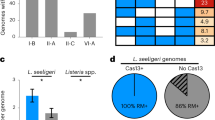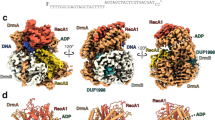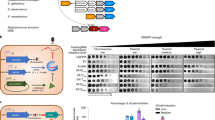Abstract
Anti-restriction proteins ArdB/KlcA specifically inhibit restriction (endonuclease) activity of restriction-modification (RM) type I systems. Molecular mechanisms of ArdB/KlcA-based anti-restriction remain unknown. In this study, we quantitate effects of ArdB on protection of unmodified λ phage DNA from EcoKI restriction. After UV irradiations, which produce significant amounts of unmodified chromosomal DNA in Escherichia coli K12 cells, the protective activity of ArdB decreases. Unlike ArdB, DNA-mimicking protein Ocr retains its ability to protect the unmodified λ phage regardless of UV dose. We hypothesize that the observed decrease in ArdB protective activity in UV-treated cells is due to its binding to unmodified chromosomal DNA, which decreases effective concentrations of free ArdB molecules available for λ phage protection against type I restriction enzymes.


Similar content being viewed by others
References
Atanasiu C, Su TJ, Sturrock SS, Dryden DTF (2002) Interaction of the Ocr, gene 0.3 protein of bacteriophage T7 with EcoKI restriction-modification enzyme. Nucleic Acids Res 30:3936–3944
Balabanov VP, Pustovoit KS, Zavilgelsky GB (2012) Comparative analysis of antirestriction activity of R64 ArdA and ArdB proteins. Mol Biol (Moskow) 46:269–275
Belogurov AA, Delver EP, Rodzevich OV (1993) Plasmid pKM101 encodes two nonhomologous antirestriction proteins (ArdA and ArdB) whose expression is controlled by homologous regulatory sequences. J Bacteriol 175:4843–4850
Blakely GW, Murray NE (2006) Control of the endonuclease activity of type I restriction-modification systems is required to maintain chromosome integrity following homologous recombination. Mol Microbiol 60:883–893
Doronina VA, Murray NE (2001) The proteolytic control of restriction activity in Escherichia coli K12. Mol Microbiol 39:416–428
Efimova EP, Delver EP, Belogurov AA (1988) 2-Aminopurine and 5-bromouracil induce alleviation of type I restriction in Escherichia coli: mismatches function as inducing signals? Mol Gen Genet 214:317–320
Goryanin II, Kudryavtseva AA, Balabanov VP et al (2018) Antirestriction activities of KlcA (RP4) and ArdB (R64) proteins. FEMS Microbiol Lett 365(23):227–229
Guan KL, Dixon JE (1991) Eukaryotic proteins expressed in Escherichia coli: an improved thrombin cleavage and purification procedure of fusion protein with glutathione S-transferase. Anal Biochem 192:262–267
Ivančić-Baće I, Vlašić I, Čogelja-Čajo G et al (2006) Roles of PriA protein and double-strand DNA break repair functions in UV-induced restriction alleviation in Escherichia coli. Genetics 174:2137–2149
Kelleher JE, Raleigh EG (1994) Response to UV damage by four Escherichia coli K-12 restriction systems. J Bacteriol 176:5888–5890
Kushner SR, Nagaishi H, Templin A, Clark AJ (1971) Genetic recombination in Escherichia coli. The role of exonuclease I. Proc Natl Acad Sci USA 68:824–827
Laemmli UK (1970) Cleavage of structural proteins during the assembly of the head of bacteriophage T4. Nature 227:680–685
Makovets S, Doronina VA, Murray N (1999) Regulation of endonuclease activity by proteolysis breakage of unmodified bacterial chromosomes by type I restriction enzymes. Proc Natl Acad Sci USA 96:9757–9762
Serfiotis-Mitsa D, Herbert AP, Roberts GA, Soares DC, White JH et al (2010) The structure of the KlcA and ArdB proteins reveals a novel fold and antirestriction activity against Type I DNA restriction systems in vivo but not in vitro. Nucleic Acids Res 38:1723–1737
Thoms B, Wackernagel W (1984) Genetic control of damage-inducible restriction alleviation in Escherichia coli K12 an SOS function not repressed by lexA. Mol Gen Genet 197:297–303
Walkinshaw MD, Taylor P, Sturrock SS et al (2002) Structure of Ocr from bacteriophage T7, a protein that mimics B-form DNA. Mol Cell 9:187–194
Zavilgelsky GB, Kotova VYu, Rastorguev SM (2011) Antimodification activity of the ArdA and Ocr proteins. Russ J Genetics 47:139–146
Funding
Russian Foundation for Basic Research 19-04-00495.
Author information
Authors and Affiliations
Corresponding author
Ethics declarations
Conflict of interest
Authors declare that thereare no conflicts of interest.
Additional information
Publisher's Note
Springer Nature remains neutral with regard to jurisdictional claims in published maps and institutional affiliations.
Rights and permissions
About this article
Cite this article
Balabanov, V.P., Kudryavtseva, A.A., Melkina, O.E. et al. ArdB Protective Activity for Unmodified λ Phage Against EcoKI Restriction Decreases in UV-Treated Escherichia coli. Curr Microbiol 76, 1374–1378 (2019). https://doi.org/10.1007/s00284-019-01755-z
Received:
Accepted:
Published:
Issue Date:
DOI: https://doi.org/10.1007/s00284-019-01755-z




